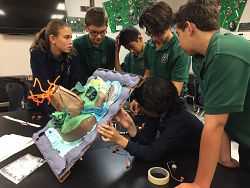Cross-curricular project engages middle school students
Friday, Jan. 27, 2017
SALT LAKE CITY – This past fall, Our Lady of Lourdes Catholic School’s technology, art and middle school teachers created and implemented a cross-curricular collaborative project between social studies, science, technology, engineering and art.
“The project is a first step in implementing the updated Diocesan Information Technology curriculum, which now incorporates the International Society for Technology in Education (ISTE) Standards,” said J.C. De Astis, middle school technology teacher and vice principal.
An essential component of ISTE Standards, technology builds self-guided learning and higher order cognition skills, such as critical thinking, creativity and exploration. Blended learning experiences help students become more actively engaged.
Working in groups over the course of seven weeks, Our Lady of Lourdes middle school students were challenged to create a diorama with specific requirements, based on their social studies curriculum. The 6th grade was learning about the Egyptian and Roman empires, 7th grade was learning about land formations, and 8th grade was learning about colonial Spanish, Aztec and Mayan cultures.
Each group determined a theme for their project, then created a written outline and blueprint drawings. They then constructed a three-dimensional model, which had to include a variety of 3D objects and littleBits modular electronics with light, sound, movement, and for extra credit, remote controlled functionality.
For the 18 months, the students have participated in a prototyping engineering class using the littleBits platform of electronic building blocks to create and test automated inventions.
When their dioramas were complete, each group had to present and demonstrate it to the class, which was graded by Principal Christine Bergquist on knowledge of theme, artistic creation and littleBits functionality.
“It was wonderful to see their hard work come to life,” said Tonni Trujillo, technology and art teacher. “We got to see a Spanish Mission and a Sphinx’s eyes light up, Pyramids spin, an exploding volcano, the effects of a tornado and an Aztec’s water farm,” she said.
“This project was a lot of fun,” said seventh-grader Aiden Clarken. “But it was a lot harder to work together than I thought it would be. We all had our own ideas and opinions that we wanted in the project.”
De Astis said students’ reaction to the self-directed learning process differed– some embraced it; a few were perplexed, but “as we blend learning more across the humanities and STEM, I think the students will realize how beneficial this type of learning really is to understanding a concept or topic.”
Eighth grader Carissa Sorensen said she liked that they were not given a lot of instruction; rather, they were given the freedom within their group to determine their needs, resources and goals to accomplish the project.
De Astis also mentioned the students have a lot to learn when presenting. “For many, it is frightening enough just to say their name in front of the class. Projects like these will continue to help them develop essential presentation skills,” he said.
Overall, the cross-curricular collaboration was a success. The students overwhelmingly said they would like more blended learning assignments because they are a fun and engaging way to gain a deeper understanding of the subjects they are learning. And as De Astis points out, “learning the importance of creativity, integration, collaboration and public speaking are all skills that are a must in the competitive employment environment.”
Courtesy of Our Lady of Lourdes School
For questions, comments or to report inaccuracies on the website, please CLICK HERE.
© Copyright 2024 The Diocese of Salt Lake City. All rights reserved.
© Copyright 2024 The Diocese of Salt Lake City. All rights reserved.


Stay Connected With Us